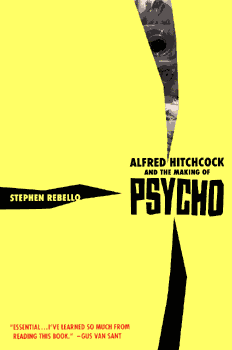|
 book review by Gary Johnson book review by Gary Johnson
One of the best books ever written about the making of a movie--Stephen Rebello's Alfred Hitchcock and the Making of Psycho (first published in 1990)--is now available in a new paperback edition from St. Martin's Griffin. If you want the inside story on one of the greatest movies ever made (it held down the number 18 slot in the American Film Institute's recent Top 100 countdown), Rebello's book is unquestionably the best source available. Rebello begins at the very beginning by giving us the real-life atrocities of Ed Gein, a 51-year-old "odd-jobs-and-errand-man" from Plainfield, Wisconsin. In November 1957, after a storekeeper disappeared, police descended on Ed Gein's rural home and discovered a horrifying variety of human bones and body parts. Writer Robert Bloch used the story of Ed Gein as the inspiration for his novel Psycho. Bloch's book received "howls of protest from critics that believed their genteel sensibilities had been violated." A Paramount script reader immediately rejected the book as "too repulsive for films." However, Alfred Hitchcock was looking for material for his next movie and he was looking for something out of the ordinary. Robert Bloch's Psycho grabbed his attention: "I think that the thing that appealed to me and made me decide to do the picture was the suddenness of the murder in the shower, coming, as it were, out of the blue. That was about all," said Hitchcock. Wisely, Rebello didn't accept Hitchcock's "that was about all" as final word on why Hitchcock chose to make Psycho. Rebello probed deeper, and in the process, Rebello discovered a variety of motivations. For example, in the wake of Henri-Georges Clouzot's vastly-popular thriller Les Diaboliques, Hitchcock wanted to set the matter straight about who was the real master of suspense. In addition, among other motivations, Rebello suggests that Hitchcock had been closely watching the box-office successes from American International, Hammer, Allied Artists and other studios that produced low-budget shockers, and he wondered how successful a first-class low-budget shocker might be. As Rebello leads us on a guided tour of the making of Psycho, Rebello hits all of the major phases of the filmmaking process--with screenwriting, casting, production design, wardrobe, and makeup receiving attention in the pre-production phase. Screenwriter Joseph Stefano provides many of the most intriguing background stories. In particular, Stefano helps us understand better how the character of Norman Bates evolved. Stefano didn't particularly see much potential in the character. As created by Robert Bloch, Norman isn't a likable character. He's a fat man in his forties who drinks habitually and peeps through holes. But when Hitchcock suggested Anthony Perkins for the role, Stefano began to see the character differently: "I suddenly saw a tender, vulnerable young man you could feel incredibly sorry for. I could rope in an audience with someone like that." While leading us through the movie's shooting schedule, Rebello addresses one of the most controversial scenes in the movie--the shower sequence--and he discusses its authorship. Saul Bass created the storyboards for this sequence and his impact is undeniable on the finished product: many of the camera shots are literal renditions of Bass's sketches. However, Bass has contented that his contributions went far beyond just sketching the storyboards. He has suggested that he actually directed the sequence--not Hitchcock. No one else seems to remember the scene that way. Janet Leigh, for example, insists Hitchcock directed the scene (and who should know better than her?), but rumors persist about the authorship of the scene. Other rumors have swirled around whether or nor Janet Leigh filmed the scene in the nude. Rebello helps put that notion to rest with his interview of wardrobe supervisor Rita Riggs, who insists that she used a glued-on moleskin covering to ensure Ms. Leigh's modesty. However, a nude model was indeed on the set, and she was used so that Hitchcock could (in his own words) "measure out the movements and the covering of the awkward parts of the body, the arm movement, gesture and so forth." Rebello doesn't stop once the filming and editing phases were completed. He also leads us through the publicity phase. In fact, this section of the book is one of its most fascinating sections, for Hitchcock played a crucial role in devising the film's marketing. Because he was afraid that the first audiences would reveal the movie's secrets, Hitchcock (with Paramount's blessing) insisted that theater owners follow the decree of the movie's posters and advertisements: "No one … BUT NO ONE … will be admitted to the theater after the start of each performance of Psycho." Publicity kits included tips for hiring Pinkerston guards to enforce the admission policies. Some theater owners complained, but box-office lines frequently stretched around the block. The commotion caused by the movie has hardly subsided today. Psycho stands as arguably the most influential movie of the last half of the twentieth century. If you're interested in the artistry of Alfred Hitchcock and the process of filmmaking, Alfred Hitchcock and the Making of Psycho is a real treasure. Rebello talked with virtually every surviving cast and crew member and uncovered the hows and whys behind the movie's fascinating history. Everything about Psycho is here in glorious detail.
Alfred Hitchcock and the Making of Psycho is now available from St. Martin's Griffin. Suggested retail price: $14.95. Trade paperback.
|
